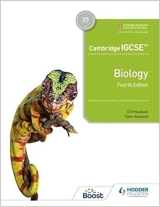Chapter 23. Variation, selection and evolution
Page 202
1. a Mainly inherited; facial features, ability to talk.
b Mainly acquired; manual skills, language.
c More or less equal mixture: body build, athleticism.
2. a The X and Y sex chromosomes are inherited independently of hair colour and texture. So
whereas the father has brown eyes and straight hair, his sons could have blue eyes and straight
hair. Similarly the mother has blue eyes and curly hair but her daughters could inherit brown
eyes and curly hair.
b The children would all have brown curly hair, unlike either of their parents.
3. Tall plant with yellow seeds TtYy. Dwarf plant with green seeds. ttyy
 |
There are two new combinations of characters: tall plants with green seeds (Ttyy) and dwarf plants with yellow seeds (ttYy) |
4. The apples on the south side will receive slightly more sunlight than those on the north side. So photosynthesis will be greater and, consequently, the fruit will be larger.
The apple leaves on the lower branches will be shaded by the foliage above and so receive less sunlight that those in the upper branches. The apples on the north side lower branches will receive least sunlight.
5. A will now be on the same chromosome as b and c so Abc will be a new combination. So will aBC.
Page 205
1. Assuming that it is the male who is competing, his plumage might be brighter and his song louder that his rivals. He might also be more aggressive towards his competitors, so leaving him space to attract a female. He might also have a more striking display pattern.
2. Selection pressures might include: drought or excessive rainfall, very high or very low temperatures, the growth rate of competing plants, the stresses of being walked on, pattern of light and shade, good or poor drainage, availability of mineral ions in the soil. The plants which are able to cope with these pressures are the ones most likely to survive and reproduce.
Page 210.
1. The amphibia were most abundant inthe Permian and Triassic periods 200 million years ago.
2. The features which suggest relationship with present-day fish are the shape of the body, scales, a tail fin and what looks like a gill opening.
3. The positions in the evolutionary tree diagram reflect the complexity of the organism and the time of appearance in the course of evolution. Worms and insects are complex organisms but not so complex as birds and mammals. Worms and insects of one kind or another appear early on in the fossil record. Birds and mammals are comparatively recent ‘arrivals’. |
Downloads
Download the answers in PDF format below
Section 1, Chapters 1-5
Section 2, Chapters 6-9
Section 3, Chapters 10-12
Section 3, Chapters 13-17
Section 3, Chapters 18-20
Section 4, Chapters 21-24
Section 5, Chapters 25-27
Section 5, Chapters 28-29
Section 6, Chapters 30-34
Section 6, Chapters 35-37
Section 7, Chapters 38-39
Section 8, Chapters 40-41
|

